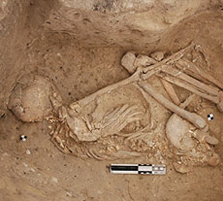
hen
you have people who are removing skulls from their dead and keeping them,
re-plastering them, painting them, and handing them down over generations,
it’s fairly clear that evidence is about the spiritual.” Professor Ian
Hodder invokes this early

Holocene Age precursor of family portraiture
as proof that archaeologists can identify religious elements in ancient
societies.

Hodder, the director of Stanford Archaeology Center, is in charge of
the three-year program “Spirituality and Religious Ritual in the Emergence
of Civilization.” This project has taken an unusually interdisciplinary
approach to the study of the role of spirituality and religious ritual
in the transition of humanity from hunter-gatherers to settled agriculturalists
and founders of civilized society. The major activities of the program
are archaeological excavation and scientific analysis, and multidisciplinary
seminars at the internationally recognized site of Çatalhöyük in central
Turkey.

The project is addressing several key questions. The first, to which
Hodder is responding in his remarks about heirloom skulls, is how can
archaeologists recognize the spiritual, religious, and transcendent in
early time periods? Another question the program asks is whether changes
in spiritual life and religious ritual are a necessary prelude to the
social and economic changes that lead to “civilization”? That has entailed
a detailed investigation of what such spiritual practices might be. “One
of the strongest,” says Hodder, “is the role of ancestors and the notion
that every aspect of daily life is imbued with the presence of the ancestors
and that looking after them is necessary for the survival of the present
and future generations.”

As for the spiritual influence on the transformation of hunter-gatherers
into farmers, Hodder says: “We’re fairly sure that’s true because we’ve
been discussing some of the new discoveries in southeast Turkey which
show that there are very large sites which exist before agriculture.
It seems to make a very good case that people came together for religious
and symbolic reasons initially, and it was that coming together which
then led to settlement and the domestication of plants and animals.”

But on another important question the team has come up with a negative
conclusion. This concerns whether violence and death acted as the foci
of transcendent religious experience in the Holocene period. “The Templeton
group has been less sure about that,” says Hodder. “There are all sorts
of interpretative problems relating to identifying images that are violent,
so I guess that is one hypothesis we would probably reject as a result
of our discussions.”

It is these interdisciplinary discussions of data that have given the
project its unique character. “We have a group of scholars consisting
of philosophers, theologians, and anthropologists who have worked with
the archaeologists at the site. Every year they have spent a week at
the archaeological site in Turkey, and we’ve had some discussions that
have been very fruitful.” There have also been meetings at Stanford and
a series of writing projects that will result in a book. “It wasn’t supposed
to be part of the original plan. But the group has been so effective
in working together that we have decided to do a publication.”

What is the big question? “I think the biggest question is why? Why did
humans settle down and have domesticated plants and animals, and start
what we now recognize as civilization? Why did they bother to do that,
since they had managed for hundreds of thousands of years before that
as hunters and gatherers? So why did it all change? Why did we become
who we are? I don’t think anyone would say that wasn’t the major question
of the period, and I don’t think anyone would say that it’s really been
resolved.”



 hen
you have people who are removing skulls from their dead and keeping them,
re-plastering them, painting them, and handing them down over generations,
it’s fairly clear that evidence is about the spiritual.” Professor Ian
Hodder invokes this early
hen
you have people who are removing skulls from their dead and keeping them,
re-plastering them, painting them, and handing them down over generations,
it’s fairly clear that evidence is about the spiritual.” Professor Ian
Hodder invokes this early  Holocene Age precursor of family portraiture
as proof that archaeologists can identify religious elements in ancient
societies.
Holocene Age precursor of family portraiture
as proof that archaeologists can identify religious elements in ancient
societies.